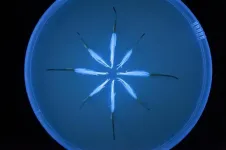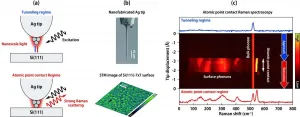Two papers published in The Astrophysical Journal report these findings, with Kyle Boone as lead author. Currently a postdoctoral fellow at the University of Washington, Boone is a former graduate student of Nobel Laureate Saul Perlmutter, the Berkeley Lab senior scientist and UC Berkeley professor who led one of the teams that originally discovered dark energy. Perlmutter was also a co-author on both studies.
Supernovae were used in 1998 to make the startling discovery that the expansion of the universe is speeding up, rather than slowing down as had been expected. This acceleration - attributed to the dark energy that makes up two-thirds of all the energy in the universe - has since been confirmed by a variety of independent techniques as well as with more detailed studies of supernovae.
The discovery of dark energy relied on using a particular class of supernovae, Type Ia. These supernovae always explode with nearly the same intrinsic maximum brightness. Because the observed maximum brightness of the supernova is used to infer its distance, the small remaining variations in the intrinsic maximum brightness limited the precision with which dark energy could be tested. Despite 20 years of improvements by many groups, supernovae studies of dark energy have until now remained limited by these variations.
Quadrupling the number of supernovae
The new results announced by the SNfactory come from a multi-year study devoted entirely to increasing the precision of cosmological measurements made with supernovae. Measurement of dark energy requires comparisons of the maximum brightnesses of distant supernovae billions of light-years away with those of nearby supernovae "only" 300 million light-years away. The team studied hundreds of such nearby supernovae in exquisite detail. Each supernova was measured a number of times, at intervals of a few days. Each measurement examined the spectrum of the supernova, recording its intensity across the wavelength range of visible light. An instrument custom-made for this investigation, the SuperNova Integral Field Spectrometer, installed at the University of Hawaii 2.2-meter telescope at Maunakea, was used to measure the spectra.
"We've long had this idea that if the physics of the explosion of two supernovae were the same, their maximum brightnesses would be the same. Using the Nearby Supernova Factory spectra as a kind of CAT scan through the supernova explosion, we could test this idea," said Perlmutter.
Indeed, several years ago, physicist Hannah Fakhouri, then a graduate student working with Perlmutter, made a discovery key to today's results. Looking at a multitude of spectra taken by the SNfactory, she found that in quite a number of instances, the spectra from two different supernovae looked very nearly identical. Among the 50 or so supernovae, some were virtually identical twins. When the wiggly spectra of a pair of twins were superimposed, to the eye there was just a single track. The current analysis builds on this observation to model the behavior of supernovae in the period near the time of their maximum brightness.
The new work nearly quadruples the number of supernovae used in the analysis. This made the sample large enough to apply machine-learning techniques to identify these twins, leading to the discovery that Type Ia supernova spectra vary in only three ways. The intrinsic brightnesses of the supernovae also depend primarily on these three observed differences, making it possible to measure supernova distances to the remarkable accuracy of about 3%.
Just as important, this new method does not suffer from the biases that have beset previous methods, seen when comparing supernovae found in different types of galaxies. Since nearby galaxies are somewhat different than distant ones, there was a serious concern that such dependence would produce false readings in the dark energy measurement. Now this concern can be greatly reduced by measuring distant supernovae with this new technique.
In describing this work, Boone noted, "Conventional measurement of supernova distances uses light curves - images taken in several colors as a supernova brightens and fades. Instead, we used a spectrum of each supernova. These are so much more detailed, and with machine-learning techniques it then became possible to discern the complex behavior that was key to measuring more accurate distances."
The results from Boone's papers will benefit two upcoming major experiments. The first experiment will be at the 8.4-meter Rubin Observatory, under construction in Chile, with its Legacy Survey of Space and Time, a joint project of the Department of Energy and the National Science Foundation. The second is NASA's forthcoming Nancy Grace Roman Space Telescope. These telescopes will measure thousands of supernovae to further improve the measurement of dark energy. They will be able to compare their results with measurements made using complementary techniques.
Aldering, also a co-author on the papers, observed that "not only is this distance measurement technique more accurate, it only requires a single spectrum, taken when a supernova is brightest and thus easiest to observe - a game changer!" Having a variety of techniques is particularly valuable in this field where preconceptions have turned out to be wrong and the need for independent verification is high.
INFORMATION:
The SNfactory collaboration includes Berkeley Lab, the Laboratory for Nuclear Physics and High Energy at Sorbonne University, the Center for Astronomical Research of Lyon, the Institute of Physics of the 2 Infinities at the University Claude Bernard, Yale University, Germany's Humboldt University, the Max Planck Institute for Astrophysics, China's Tsinghua University, the Center for Particle Physics of Marseille, and Clermont Auvergne University.
This work was supported by the Department of Energy's Office of Science, NASA's Astrophysics Division, the Gordon and Betty Moore Foundation, the French National Institute of Nuclear and Particle Physics and the National Institute for Earth Sciences and Astronomy of the French National Centre for Scientific Research, the German Research Foundation and German Aerospace Center, the European Research Council, Tsinghua University, and the National Natural Science Foundation of China.
Additional background
In 1998, two competing groups studying supernovae, the Supernova Cosmology Project and the High-z Supernova Search team, both announced they had found evidence that, contrary to expectations, the expansion of the universe was not slowing but becoming faster and faster. Dark energy is the term used to describe the cause of the acceleration. The 2011 Nobel Prize was awarded to leaders of the two teams: Saul Perlmutter of Berkeley Lab and UC Berkeley, leader of the Supernova Cosmology Project, and to Brian Schmidt of the Australian National University and Adam Riess of Johns Hopkins University, from the High-z team.
Additional techniques for measuring dark energy include the DOE-supported Dark Energy Spectroscopic Instrument, led by Berkeley Lab, which will use spectroscopy on 30 million galaxies in a technique called baryon acoustic oscillation. The Rubin Observatory will also use another called weak gravitational lensing.
Founded in 1931 on the belief that the biggest scientific challenges are best addressed by teams, Lawrence Berkeley National Laboratory (https://www.lbl.gov/) and its scientists have been recognized with 14 Nobel Prizes. Today, Berkeley Lab researchers develop sustainable energy and environmental solutions, create useful new materials, advance the frontiers of computing, and probe the mysteries of life, matter, and the universe. Scientists from around the world rely on the Lab's facilities for their own discovery science. Berkeley Lab is a multiprogram national laboratory, managed by the University of California for the U.S. Department of Energy's Office of Science.
DOE's Office of Science is the single largest supporter of basic research in the physical sciences in the United States and is working to address some of the most pressing challenges of our time. For more information, please visit energy.gov/science.
-By Bob Cahn









